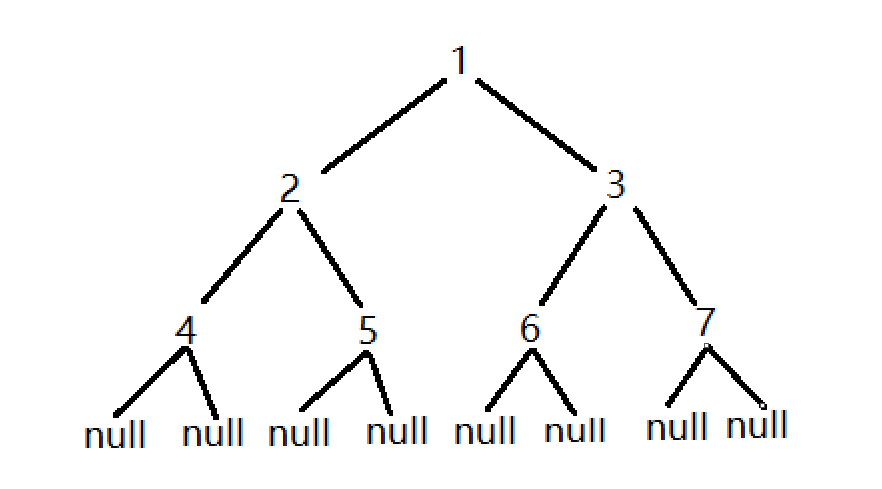二叉树
二叉数:
二叉树递归遍历
二叉树非递归遍历
宽度优先遍历
搜索二叉树
完全二叉树
满二叉树
平衡二叉树
// 二叉树节点
class Node<V> {
V value;
Node left;
Node right;
}
头节点:也叫根节点,二叉树最顶端的节点(无无父结点)
叶节点:左右子节点都为null
子树:以任意一节点为根,其衍生下可以直接相连或经过节点相连的全部节点组成的树
二叉树遍历:
使用递归方式实现:
// 二叉树每个节点遍历时都有三次访问
public static void f(Node head) {
//1:start
if (head == null) {
return null;
}
...
// 1:end
f(head.left);
// 2:start
...
// 2:end
f(head.right);
// 3:start
...
// 3:end
}
*先序,中序,后序遍历即是在第一次,第二次,第三次访问节点时做反应

遍历打印(每次访问打印一次value):
1 2 4 4 4 2 5 5 5 2 1 3 6 6 6 3 7 7 7 3 1
先序访问顺序(对每颗子树 头左右):
1 2 4 5 3 6 7
中序访问顺序(对每颗子树 左头右):
4 2 5 1 6 3 7
后序访问顺序(对每颗子树 左右头):
4 5 2 6 7 3 1
使用非递归方式实现二叉树:
先序遍历:
- 创建一个栈(Stack)对象,将头节点压入栈列
- 弹出栈顶节点 Car
- 打印处理 Car
- 先压入右节点,再压入左节点(有就压)
- 返回第二步,直至栈空
//代码实现
public static void preOrder(Node head) {
if(head != null){
Stack<Node> stack = new Stack<Node>();
stack.push(head);
while(!stack.isEmpty()) {
head = stack.pop();
System.out.println(head.value());
if(head.right != null) {
stack.push(head.right);
}
if(head.left != null) {
stack.push(head.left);
}
}
}
}
中序遍历:
- 创建一个栈,将数的最左边界依次压入
- 弹出打印栈顶元素,若栈顶存在右子树,将右子树的最左边界依次压入
- 循环2,直至栈空
public static void (Node head) {
if(head != null) {
Stack<Node> stack = new Stack<>();
while(!stack.isEmpty() || head != null) {
if(head != null) {
stack.push(head);
head = head.left;
}else {
head = stack.pop();
System.out.println(head.value());
head = head.right;
}
}
}
}
后序遍历:
- 创建两个栈(存储栈和收集栈)
- 弹出存储栈头节点,压入收集栈
- 将2中弹出的节点,以先压左节点再压右节点的顺序压入存储栈
- 返回2,直到存储栈为空
- 依次打印收集栈顺序
public static void posOrder(Node head) {
if(head != null) {
Stack<Node> st1 = new Stack<>();
Stacj<Node> st2 = new Stack<>();
st1.push(head);
while(!st1.isEmpty()){
head = st1.pop();
st2.push(head);
if(head.left != null){
st1.push(head.left);
}
if(head.right != null) {
st1.push(head.right);
}
}
while(!st2.isEmpty()){
System.out.println(st2.pop().value);
}
}
}
实现二叉树的宽度优先遍历:
使用队列:
- 创建一个队列(Queue)对象,将头节点放入队列
- 弹出打印队列首个对象,将其左子树先放入队列,再放其右子树(如果有)
- 循环2,直到队列为空
public static void widthOrder(Node head) {
if(head == null) return;
Queue<Node> queue = new LinkedList<>();
queue.add(head);
while(!queue.isEmpty()) {
head = queue.poll();
System.out.println(head.value);
if(head.left != null) {
queue.add(head.left);
}
if(head.right != null) {
queue.add(head.right);
}
}
}
算法题:求一个二叉树的最大宽度?
- 创建一个队列(Queue)对象,将头节点放入队列
- 创建一个hashMap对象,用于记录节点与当前所在深度,将<head, 1>记录
- 创建初始深度(int)设为1,初始节点数(int)设为0,初始最大值(int)设为Integer.MIN_VALUE;
- 弹出队列首个对象,并根据HashMap判断该节点是否是当前深度的节点,是:节点数++,否:最大值=max(max,节点数),深度++,节点数设为1
- 将其左子树先放入队列,hashMap放入<head.left,深度+1>;再放其右子树,hashMap放入<head.right,深度+1>(如果有)
- 循环2-5,直到队列为空
- 调用Max函数计算最后一行节点个数和最大节点的比较
public static void getMaxWidth(Node head) {
if(head == null) return;
Queue<Node> queue = new LinkedList<>();
queue.add(head);
HashMap<Node,Integer> levelMap = new HashMap<>();
levelMap.put(head,1);
int curlevel = 1; //当前层数
int curNodeNum = 0; //当前节点数
int max = Integer.MIN_VALUE; //最大节点值
while(!queue.isEmpty()) {
head = queue.poll();
int levelNode = levelMap.get(head);
if(levelNode == curlevel) { //判断是否变层
cerNodeNum ++; //未变层,节点数++
}else {
max = Math.max(max, curNodeNum); //下一层,结算上一层的max,重置当前节点数
curLevel ++;
curNodeNum = 1;
}
if(head.left != null) {
queue.add(head.left);
levelMap.put(head.left,curlevel+1) //记录左子树以及其对应层,用于后续判断
}
if(head.right != null) {
queue.add(head.right);
levelMap.put(head.right,curlevel+1) //记录右子树以及其对应层,用于后续判断
}
}
max = Math(max, curNodeNum);
}
*不使用哈希表完成上述题目:
使用两个Node变量替代哈希表(当前层最后的节点,下一层最后的节点)
将head赋予当前层最后节点,在每次新添左右节点时,分别更新下一层最后节点为左右节点
每次队列弹出都检查是否是当前层最后节点,是:更新最大值,拷贝下一层最后节点至当前层最后节点,层数++;否:节点数++
二叉树深度优先遍历:先序遍历
搜索二叉树:
对于每一个子树,都满足其左树值比根节点值小,右树值比根节点大(一般不存在重复值)
如何判断是否是搜索二叉树:中序遍历为升序
public static int prevalue = Integer.MIN_VALUE;
public static boolean isBSt(Node head) {
if(head == null) return true;
boolean isLeftBst = isBST(head.left); //左子树是否为搜索二叉树
if(!isLeftBst) return false;
if(head.value <= preValue) { //升序判断,动态检查
return false;
}else {
preValue = head.value;
}
return isBST(head.right); //左子树是搜索二叉树,右子树是否为搜索二叉树
}
非遍历判断同理
总结返回信息:
对于左子树:1.左树应是搜索二叉树 2.获取左数的最大值(用于与根比较)
对于右子树:1.右树应是搜索二叉树 2.获取右数的最小值(用于与根比较)
统一左右子树返回信息:是否是搜索二叉树,最小值,最大值
判断是否为搜索二叉树:
public static boolean checkBST(Node head) {
return process(head).isBST;
}
//返回类型
public static class ReturnType {
public boolean isBST;
public int min;
public int max;
public ReturnData(boolean isb, int min, int max){
this.isBST = isb;
this.min = min;
this.max = max;
}
}
public static ReturnType process(Node x) {
if(x == null) return null;
ReturnType leftData = process(x.left);
ReturnType rightData = process(x.right);
//获得整个子树的最大最小值
int min = x.value;
int max = x.value;
if(leftData != null) {
min = Math.min(min,leftData.min);
max = Math.max(max,leftData.max);
}
if(rightData != null) {
min = Math.min(min,rightData.min);
max = Math.max(max,rightData.max);
}
boolean isBST = true;
if(leftData != null && (!leftData.isBST || leftData.max >= x.value) {
isBST = false;
}
if(rightData != null && (!rightData.isBST || x.value >= rightData.min) {
isBST = false;
}
return new ReturnType(isBST,min,max);
}
完全二叉树:
所有节点依次按从左往右依次放入的二叉树属于完全二叉树
- 任意一节点有右孩子无左孩子 → 不是完全二叉树
- 宽度优先遍历且在不违反1前提下,出现首个左右孩子不双全时,之后的节点都应该是叶子节点
public static boolean isCBT(Node head) {
if(head == null) return true;
//是否遇到过左右孩子不双全的判断
boolean leaf = false;
Node l = null;
Node r = null;
Queue<Node> queue = new LinkedList<>();
queue.add(head);
while(!queue.isEmpty()) {
head = queue.poll();
l = head.left;
r = head.right;
if((leaf && (l!=null || r!=null)) //条件2
||
(l == null && r == null) //条件1
){
return false;
}
if(l != null) {
queue.add(l);
}
if(r != null) {
queue.add(r);
}
if(l == null || r == null) {
//leaf 为不可逆改变
leaf = true;
}
}
return true;
}
满二叉树:
子节点要么都有,要么都没有,不存在只存在一边节点的二叉树
判断是否为满二叉树:
public static boolean isFBT(Node head) {
if(head == null) {
return true;
}
info data = process(head);
return data.nodes == ((1<<data.height) - 1);
}
//返回信息
public static class Info {
public int height; //高度
public int nodes; //节点数
public Info(int hei, int nod) {
this.height = hei;
this.nodes = nod;
}
}
//过程函数,返回类型为ReturnType
public static Info process(Node x) {
if(x == null) {
return new Info(0, 0);
}
Info leftData = process(x.left);
Info rightData = process(x.right);
int height = Math.max(leftData.height,rightData.height)+1;
int nodes = leftData.nodes + rightData.nodes + 1;
return new Info(height, nodes);
}
平衡二叉树:
对于任意一颗子树,其左树高度和右树高度差不少过1
- 节点左树是平衡二叉树
- 节点右树是平衡二叉树
- |节点左树高度 - 节点右数高度| <= 1
以上条件对每个节点都成立,这个树就是平衡二叉树,否则不是
总结返回信息:
对于左树,我们希望知道:1.左树是否是平衡二叉树 2.左树高度
对于右数,我们希望知道:1.右树是否是平衡二叉树 2.右数高度
左右树需要的信息一致;
判断是否为平衡二叉树:
//返回值的变动,调用其他方法返回
public static boolean isBT(Node head) {
return process(head).isBalanced;
}
//返回信息
public static class ReturnType {
public boolean isBalanced; //是否是平衡二叉树
public int height; //高度
public ReturnType(boolean isB, int hei) {
this.isBalanced = isB;
this.height = hei;
}
}
//过程函数,返回类型为ReturnType
public static ReturnType process(Node x) {
if(x == null) {
return new ReturnType(true, 0);
}
ReturnType leftData = process(x.left);
ReturnType rightData = process(x.right);
int height = Math.max(leftData.height,rightData.height)+1;
boolean isBalance = leftData.isBalanced && rightData.isBalanced
&& Math.abs(leftData.height - rightData.height) < 2;
return new ReturnType(isBalance, height);
}
https://xcscx.github.io/2022/08/12/%E6%95%B0%E6%8D%AE%E7%BB%93%E6%9E%84/%E4%BA%8C%E5%8F%89%E6%A0%91/
本博客所有文章除特别声明外,均采用 CC BY-NC-SA 4.0 许可协议。转载请注明来自 IT蛋的个人博客!


